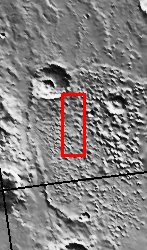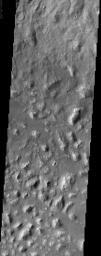Ariadnes Colles Chaos
Caption:

(Released 18 June 2002)
Among the many varied landscapes on Mars the term chaos is applied to those places that have a jumbled, blocky appearance. Most of the better known chaotic terrain occurs in the northern hemisphere but there are other occurrences in the southern hemisphere, three of which are centered on ~180 degrees west longitude. Ariadnes Colles, Atlantis, and Gorgonum Chaos all share similar features: relatively bright, irregularly shaped knobs and mesas that rise above a dark, sand-covered, hummocky floor. Close inspection of this THEMIS image shows that the darker material tends to lap up to the base of the knobs and stops where the slopes are steep. On some of the lowest knobs, the dark material appears to overtop them. The knobs themselves are highly eroded, many having a pitted appearance. Images from the camera on Mars Global Surveyor clearly show that the dark material is sand, based on its mantling appearance and the presence of dunes. It looks as though the material that composes the knobs was probably a continuous layer that was subsequently heavily eroded. While it is likely that the dark sand is responsible for some of the erosion it is also possible that the this landscape was eroded by some other process and the sand was emplaced at a later time.
Cataloging Keywords:
| Name |
Value |
Additional Values |
| Target |
Mars |
|
| System |
|
|
| Target Type |
Planet |
|
| Mission |
2001 Mars Odyssey |
Mars Global Surveyor (MGS) |
| Instrument Host |
Mars Odyssey |
Mars Global Surveyor |
| Host Type |
Orbiter |
|
| Instrument |
Thermal Emission Imaging System (THEMIS) |
|
| Detector |
|
|
| Extra Keywords |
Dune, Grayscale |
| Acquisition Date |
|
| Release Date |
2002-06-26 |
| Date in Caption |
2002-06-18 |
|
| Image Credit |
NASA/JPL/Arizona State University |
| Source |
photojournal.jpl.nasa.gov/catalog/PIA03831 |
| Identifier |
PIA03831 |


